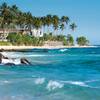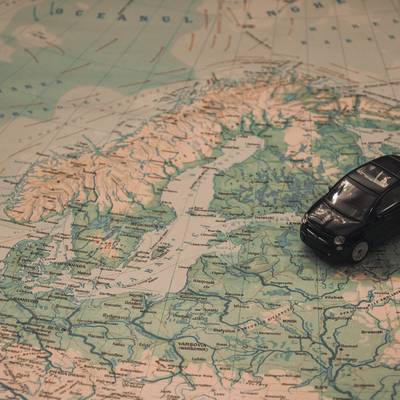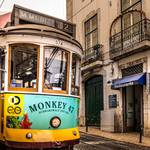General
 What is the best time to visit Portugal?
What is the best time to visit Portugal?
 What is the climate like in Portugal?
What is the climate like in Portugal?
 How do I access internet in Portugal?
How do I access internet in Portugal?
 What NOT to do in Portugal?
What NOT to do in Portugal?
 Where should I go in Portugal for 2 weeks?
Where should I go in Portugal for 2 weeks?
 What type of adapter do I need for the outlets?
What type of adapter do I need for the outlets?
 What should I pack for my trip?
What should I pack for my trip?
Transport
People
Accomodation
Food & Drink
Sightseeing
Legal
Money
Safety & Health
Family travel

Where should I go in Portugal for a week?
Do you only have one week to explore Portugal? It's better to see as many sides of this beautiful country as possible, by starting at the Algarve and making your way north to Porto. Although one week isn’t enough time to dig deep into the culture or head off the beaten track, it can give ambitious travelers a good first impression of this fantastic country.
Days 1 – 2: The Algarve. The two main international airports are in Lisbon and Porto; the third is in Faro, but consider entering the country through one of the first two and then catching a connecting flight to Faro. There are also trains and buses that head into the Algarve, but some travelers may prefer flying to get there more quickly (flights from Lisbon take about 45 minutes).
In the Algarve, the coast is the shining star and the region is lined with stunning beaches that look too beautiful to be true. Lagos, Albufeira, Portimão, and Tavira are a few of the more popular city stops highlighted by spectacular beaches, seaside caves, and multi-toned cliffs. Stop at Camilo Beach, Benagil Cave, the Beach of Three Brothers (Praia dos Três Irmãos), and the lighthouse at Piedade Point. Renting a car is the easiest way to jump from one sight to the next.
Some visitors like to get in the water as soon as possible, while others prefer enjoying the coast from afar. Trekking, surfing, sunbathing, and kayaking are just a few of the popular activities on offer.
Another gem in the Algarve is the Ria Formosa lagoon system and its islands, a natural treasure that is listed as one of Portugal’s Seven Natural Wonders and located around Faro’s coast. In the Ria Formosa, birdwatching is a unique treat and there are more than 200 bird species here.
Do you consider yourself a seafood connoisseur? Portugal’s charming fishing villages are filled with excellent restaurants offering freshly caught fish and seafood on their daily menus. The best seafood dish to try in the Algarve is the mixed seafood cataplana: steam-cooked fish and shellfish in a traditional copper pot.
Days 3 – 4: Lisbon, Belém, and Sintra. Drive or hop on a train and head north to Lisbon, Portugal’s lively and artistic capital city. After arriving and sampling your first pastel da nata, spend a few hours meandering through and exploring the winding streets of Alfama, the oldest neighborhood in the city and the most popular spot to hear fado, Portugal’s magically melancholic traditional music.
For snapping photos and embracing stunning panoramic views, try visiting the São Jorge Castle and a few local neighborhood miradouros (viewpoints).
Where should you eat amidst all that sightseeing? Finding a nice spot is sometimes as easy as closing your eyes and pointing as the restaurants are everywhere. Order some local food like frango assado, Portugal’s take on spicy grilled chicken; or head to Cais do Sodré and choose one of the tascas or riverside cafés for a quick meal with a view.
An afternoon in Lisbon is an excellent time to head to Belém, where it’s possible to tour magnificent buildings with significant heritage importance. The Jeronimos Monastery, the Belém Tower, and the Discoveries Monument are three key landmarks not to miss.
No doubt, Sintra deserves a full day dedicated to it, so visit the day after arriving in Lisbon. The easiest way to get there is by train from Lisbon’s Rossio Station (don’t forget to snap a few photos of the station’s ornate entrance). The train ride lasts about an hour and costs 2.25 EUR each way.
It’s best to visit Sintra with a plan and know which castles and palaces you want to see most. The Pena Palace, Quinta da Regaleira, and Castle of the Moors may arguably be the three most popular landmarks for first-time visitors.
Day 5: Coimbra or Aveiro. Make your way to Porto, but fit in enough time for one stop first. Two great locations to choose from are the historic riverside city of Coimbra, located in central Portugal and home to the country’s oldest university, and Portugal’s Art Nouveau capital, Aveiro, a romantic city nicknamed “The Venice of Portugal.”
Days 6 – 7: Porto. Finally, wrap up your trip in traditional Porto, home of delicious croissants (just ask the locals about their love of Porto’s croissants), the francesinha calorie bomb, sweet Port wine, crisp Vinho Verde, and amazing landmarks that give the city its own special personality.
By the end of a busy week-long voyage through this amazing country, it’s probably time for a little rest and relaxation, but first, make sure to visit the Ribeira District for some more sightseeing. History buffs may like seeing the house where Henry the Navigator was born, called the Casa do Infante, and you can also check out some of the incredible displays of azulejo mosaics that Porto is home to.
A few last-minute activities to fit in before saying adeus to Portugal include a wine-tasting at one of Porto’s local wineries, going for a walk along a nearby beach, taking in a spectacular view from a rooftop terrace, and shopping in one of the local markets.

What can I bring home from Portugal?

Can I drink tap water in Portugal?

What are the restrictions regarding alcohol consumption?

How do I use ATMs in Portugal?

Where should I go in Portugal for 2 weeks?
